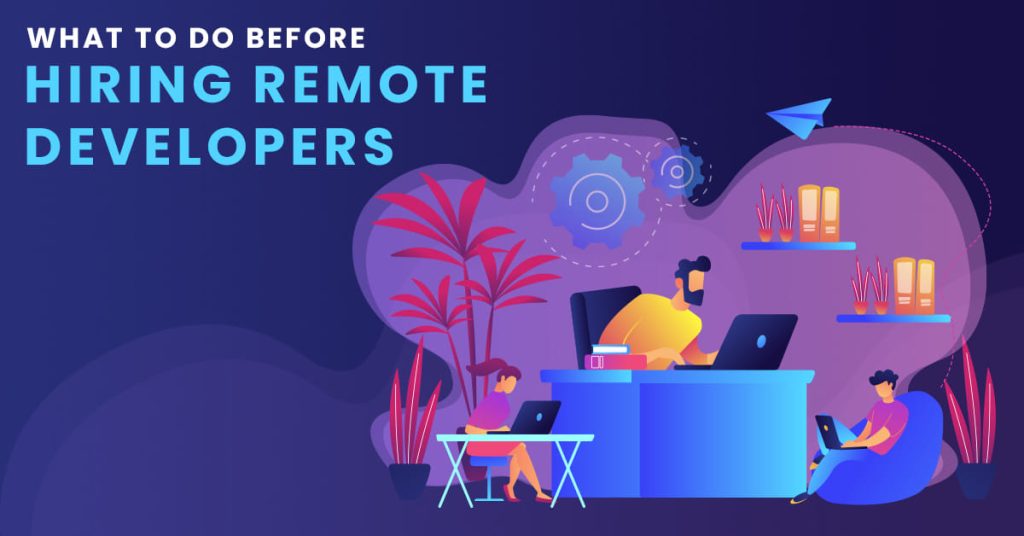Onboarding new hires is a crucial step in building a productive and engaged team. However, it is quite common to face challenges in the onboarding process when you hire remote developers as a part of outsourcing software development or mobile app development projects.

Remote developers are likely to have concerns such as a lack of communication in person, differences in cultures and time zones, and ultimately technical know-how. Therefore, it is quite important to establish a well-planned and effective onboarding process for remote developers to feel privileged, welcomed, and synced into the team.
Here are some of the key steps that we recommend for creating a successful onboarding process for remote developers:
Prepare before the start date
The onboarding process should start before the remote developer joins the team. This means preparing the necessary tools, documents, and resources that the remote developer will need to get started. For example, you should provide access to the code repository, project management software, communication channels, and any other relevant platforms or applications.
You should also send a welcome email that introduces the remote developer to the team, the project, and the expectations; additionally, it is better to have a checklist of tasks that shows the timeline or deadline of various tasks such as setting up their workstations, deploying software, testing their broadband connection, etc.
Schedule a virtual orientation session
On the first day of work, you should schedule a virtual orientation session with the remote developer. Many consider this as an opportunity to include them in the team, check on the project scopes and business objectives, enlighten them with the workflow and development methods, and address any concerns they have.
You can also introduce them to other team members and stakeholders who they will be working with. The orientation session should be interactive and engaging, using video calls, screen sharing, and chat tools. You should also provide feedback and guidance throughout the session to ensure that the remote developer understands their role and responsibilities.
Assign an expert or mentor
One of the best ways to help remote developers feel supported and connected is to assign them an expert or mentor who can assist them during the onboarding process and beyond. The person you assign should have more experience and knowledge about the project and the company culture and can provide guidance, feedback, and advice to the remote developer.
It is also possible to help them with technical know-hows, code parsing, troubleshooting, and so on. An expert or mentor can also act as a social contract who can help the remote developer get to know other team members and feel part of the team.
Set clear goals and expectations
Another important step in creating a successful onboarding process for remote developers is to set clear goals and expectations for their performance and output. You should communicate what you expect from them in terms of quality, quantity, deadlines, deliverables, and so on.
You should also define how you will measure their progress and success and how you will provide feedback and recognition. Encouraging them to set their own goals and expectations for their learning and development and helping them achieve them also make onboarding smoother.
Provide regular feedback and support
Finally, you should provide regular feedback and support to the remote developer throughout the onboarding process and beyond. You should also keep a sharp eye on how they perform tasks, what challenges they face, and what they learn from their mistakes.
You are also suggested to provide productive feedback on their work and help them improve their services and knowledge. Plus, it is suggested to recognize their achievements and celebrate their milestones. Providing regular feedback and support can help remote developers feel valued, motivated, and confident in their work.
The best practices for a successful onboarding process for remote developers
Here are some tips and best practices for building a successful remote developer onboarding experience.
Setting clear expectations and goals for the new hires
One of the primary steps in any onboarding process is to have clear objectives and goals for the new hires. This is quite crucial for onboarding remote developers, who are likely to have a not-so-clear sense of their roles and responsibilities in the team. You should communicate with them about:
- What are their main tasks and projects?
- What are the expected outcomes and deliverables?
- What are the quality standards and best practices?
- How will their performance be measured and evaluated?
- How will they collaborate with their teammates and other stakeholders?
To create a successful onboarding process for remote developers, it is recommended to provide them with a clear blueprint or timeline for their inclusion in the team; hence, they would know what to expect and what to focus on in their initial days. You can use tools like Trello to create a visual representation of their onboarding plan and assign tasks and deadlines accordingly.
Providing them with the necessary tools and resources
Another key aspect of remote developer onboarding is to provide them with the necessary tools and resources to do their job effectively. This includes:
- Hardware: It is mandatory for them to have advanced machines i.e., laptop, monitor, keyboard, mouse, headset, webcam, etc. that meet your technical requirements and standards.
- Software: Make sure they have access to your code repository, development environment, testing tools, deployment tools, etc. You should also provide them with documentation, tutorials, guides, etc. that explain how to use these tools.
- Security: It is important for onboarding remote developers to follow your security policies and protocols, such as using VPNs, encryption, passwords, and so on. Additionally, get them trained on how to prevent and handle malware attacks, data breaches, and other cyber issues.
- Support: For support, you must assign them a mentor who can help them with any technical issues or questions they may have. You should also have a dedicated IT support team who can assist them with any hardware or software problems.
Creating a welcoming and supportive culture
Experts also opine that a big challenge for remote workers is to have a sense of belonging and engagement among team members. This goes true for newcomers who could have an impression of being isolated or disconnected from other members. To create a welcoming and supportive culture for your remote developers, you should:
- Introduce them to their teammates and other relevant people in your organization. You can use video calls, chat platforms, email newsletters, etc. to facilitate introductions and interactions.
- Involve them in your team meetings, stand-ups, retrospectives, etc. You should also invite them to share their opinions, ideas, feedback, etc. in these meetings.
- Recognize their achievements and contributions. You can use tools like Slack or Microsoft Teams to send shout-outs, praise, badges, etc. to your new hires when they complete a task or project successfully.
- Celebrate their milestones and anniversaries. You can use tools like Zoom or Skype to host virtual parties, games, quizzes, etc. to celebrate their birthdays, work anniversaries, etc.
Establishing regular communication and feedback channels
Communication is the backbone of any team collaboration. And, it is even critical for remote developers who have the least chances to interact face-to-face; hence, to establish regular communication and feedback channels for your remote developers, you should:
- Choose the right communication tools for your team
- Define the communication norms and etiquette for your team
- Define the goals and expectations of the remote developer role clearly and transparently
- Provide a comprehensive and engaging orientation program that covers the company culture, values, vision, policies, and tools
- Assign a mentor or buddy to the new remote developer who can offer guidance, feedback, and support throughout the onboarding process
- Schedule regular check-ins and meetings with the new remote developer and their team members to foster communication, collaboration, and trust
- Encourage social interaction and informal bonding among the new remote developer and their colleagues through virtual events, games, or chat channels
- Solicit feedback from the new remote developer on their onboarding experience and make improvements based on their suggestions
Are you ready to welcome them?
There are innumerable benefits to hiring remote developers, and following the simple steps mentioned earlier can make their onboarding smoother and more fruitful. They will be happy and you will not regret the outcome they produce out of their zeal and enthusiasm.




Recent Comments